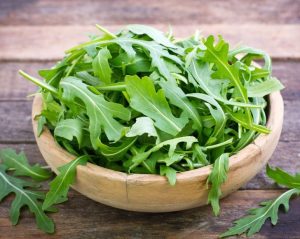Some days, I just want to eat something good and clean without overthinking it.
After giving a talk on the power of local food to a group of corporate employees, I felt energized—but also completely drained. I passed a dozen drive-thrus on the way home, tempted by the ease of grabbing something fast. But I knew better.
Because in my fridge, I had what I needed: sourdough bread, grass-fed butter, and pastured eggs. No guesswork. No compromise. Just real food I could trust.
That’s the beauty of seasonal greens and pastured eggs—they’re simple, nourishing, and always ready to anchor a quick meal that actually supports your health.
If there’s one combo that never lets us down in the kitchen—or the garden—it’s this one.
These two are the backbone of quick, nourishing meals that celebrate what’s fresh, local, and good for your body.
This time of year, our market boxes are bursting with bold leafy greens like kale, mustard, and dandelion—each one packed with flavor and nutrients.
Add in our richly golden-yolked eggs from hens raised on pasture, and you’ve got the makings of effortless meals with serious health benefits.
Let’s explore how to turn this powerful pair into simple, delicious dishes all week long.
FEATURED: Seasonal Greens and Pastured Eggs
Greens are full of flavor, fiber, and goodness—and they’re easier to enjoy than you might think. Start with familiar ones like spinach or loose leaf lettuce, then add in bolder options like kale, watercress or dandelion a little at a time. Cook them lightly, mix them into meals, or toss them into soups and grain bowls. However you use them, greens bring nourishment and balance to the plate without a lot of fuss.
Eggs are a natural partner to greens—quick to cook, endlessly flexible, and satisfying any time of day. Fold them into a skillet with wilted greens, poach them over soup, or top a salad or grain bowl for a little extra richness. They make meals feel complete without a lot of extra work.
Whether you’ve got a handful of fresh greens, a carton of eggs, or both, there’s plenty you can do with just a few ingredients and a little time. These easy meals are built around what’s on hand, with flexible, no-stress ways to enjoy the season’s best.
MEAL IDEAS FOR YOUR LOCAL ORGANIC FOOD THIS WEEK:
Many of these recipes include produce or other items you may have received in your market box. You may also see ingredients you can purchase at the WHF General Store. Experiment and see what you can use to create your meal plan!
💡Pro tip: Always check your recipes to see what you have and what you need to purchase. Takes a few extra minutes in planning, but it beats finding out at the last minute that you’re missing ingredients!
🍳 Garlicky Greens & Eggs on Toast
A savory, bright, and simple way to enjoy bold greens with runny eggs and crusty bread.
Ingredients: Kale, dandelion or mustard greens, green garlic or garlic chives, olive oil, 2 eggs, bread
Method: Sauté chopped garlic in olive oil. Add chopped greens; cook until wilted. Fry or poach eggs. Serve over toast with greens.
🥚 Skillet-Baked Eggs with Mustard Greens & Mushrooms
A hearty one-pan meal with peppery greens and creamy eggs that’s great for any time of day.
Ingredients: Mustard greens, cremini mushrooms, green onions, 3–4 eggs, olive oil or butter, salt & pepper
Method: Sauté mushrooms and onions. Add greens, cook until soft. Make wells, crack in eggs. Cover and cook until set.
🥗 Warm Watercress & Egg Salad
Bright and bitter greens mellowed by soft egg and crisp spring veggies for a fresh and filling meal.
Ingredients: Watercress greens, cherry tomatoes, French breakfast radishes, 2 boiled eggs, olive oil, vinegar, salt
Method: Boil eggs. Toss greens, tomatoes, and radishes with oil and vinegar. Top with sliced eggs.
💡Tip: You can mix and match greens in almost any salad. Start with something familiar like spinach or loose leaf lettuce, then toss in a handful of mustard, dandelion, or whatever else you’re curious about. A little bitterness brings character, and you can always soften it with sweet apple slices, a soft-boiled egg, or a splash of lemon. Don’t overthink it—just start mixing and tasting.
💡Tip: Hard-boiled eggs and greens are a quiet power couple. Keep a few eggs in the fridge, and you’ve got an easy add-on for any salad or grain bowl. especially ones with bold greens like dandelion or mustard. The egg softens the bite, adds protein, and turns a side into a real meal.
🐟 Oven-Baked Salmon with Kale & Roasted Sweet Potato
Comforting and tender with sweet potato’s mellow sweetness.
Ingredients: Salmon fillet, kale, garlic chives, lemon, olive oil, salt, pepper, sweet potato.
Method: Roast diced sweet potato at 400°F for 25–30 minutes until tender and golden. Sauté garlic chives and kale in olive oil until wilted. Bake salmon at 375°F for 12–15 minutes, seasoned with salt, pepper, and lemon. Serve salmon alongside greens and sweet potato.
🐟 Pan-Seared Salmon with Mustard Greens & Fresh Radish Salad
Light, bright, and crisp with peppery radishes and crispy skin.
Ingredients: Salmon fillet, mustard greens, garlic chives, lemon, olive oil, salt, pepper, radishes.
Method: Toss thinly sliced radishes with lemon juice, olive oil, and salt. Sauté garlic chives and mustard greens in olive oil until wilted. Pat salmon dry, season, then pan-sear skin side down in hot oil until crispy (4–5 mins), flip and cook another 3–4 mins. Finish with lemon. Serve salmon with greens and radish salad.
🍗 Chicken & Bok Choy Egg Fried Rice
Fast, flexible, and filling way to use leftover rice with crisp greens and protein.
Ingredients: Bok choy, green onions, eggs, cooked chicken (shredded), cooked rice, oil, soy sauce
Method: Scramble eggs, set aside. Sauté chopped bok choy and green onions. Add chicken and rice. Stir in eggs, season with soy sauce.
🍲Hearty Greens, Grain & Bean Soup
Flexible, filling, and packed with protein. Use any greens (mustard, dandelion, kale), cooked grain (quinoa, farro, sorghum), and beans, plus optional meat or eggs.
Ingredients: Greens, cooked grain, onion, carrots, celery, garlic, broth/water, cooked beans (any kind), optional chicken/beef/eggs
Method: Sauté onion, carrots, celery, garlic. Add broth, simmer. Stir in greens, grain, and beans. Add protein or crack eggs in to poach. Season and serve.
💡Tip: Use leftover cooked grains, beans, and meats for quick, nourishing meals.
🥩 Greens & Beef Stir-Fry
Bold greens soak up the savory sauce and pair perfectly with tender beef in this fast and flavorful meal.
Ingredients: Mustard or dandelion greens, green garlic, ginger, thinly sliced beef, soy sauce, oil
Method: Sear beef in hot oil, remove. Sauté garlic and ginger, then add greens. Return beef, splash with soy sauce, and stir to combine.
🍄 Portobello Mushroom & Red Russian Kale Sauté
Earthy mushrooms and hearty kale make a simple, satisfying side or main.
Ingredients: Portobello caps, red Russian kale, garlic, olive oil, salt, pepper, lemon juice.
Method: Slice mushrooms and sauté in olive oil with garlic until browned. Add chopped kale, salt, and pepper; cook until kale is tender. Finish with a squeeze of lemon. Great as a side or over grains.
💡Tip: If a green feels too intense raw, just cook it down a little. A quick sauté in olive oil with garlic or green onion takes the edge off mustard, kale, or dandelion. Finish with a splash of vinegar, a squeeze of lemon, or even a bit of grated cheese. Cooked greens are warm, hearty, and super forgiving.
BREAD & BAKERY:
- Nothing goes with greens and eggs like hearty sourdough bread. Add a loaf (or two) to your market box so you’re prepared for this week’s meal ideas, plus enough for sandwiches.
- 💡Tip: Make sure you never run out of your favorite bread with our Sourdough Bread Subscription.
- If you haven’t tried our sourdough pastries, you’re missing out! We have sourdough danish, cinnamon rolls, croissants, and scones. Yum!
MEAT & SEAFOOD:
- We’re into cookout season! Be sure to pick up your favorite grilling meats. Whether you like salmon burgers, beef burgers, brats, steak, ribs, or chicken on the grill, we’ve got you covered!
DAIRY:
🥚Eggs are on special this week! Buy two dozen eggs and get one free. Perfect for breakfast (or any time of day!), making pickled and deviled eggs, adding to grain bowls, and so much more. Check out the meal ideas above to help you plan.
- Eggs are delicious with a little bit of cheese. Choose your favorite and add to egg dishes, sandwiches, and salads.
- 💡Tip: Did you know you can add a cheese subscription to your market box order? Look under the Dairy & Eggs section of our Subscriptions page to find your favorites.
- Fromage blanc is delicious with sourdough toast and raw or sautéed greens. Makes a quick breakfast or lunch!
PANTRY RECOMMENDATIONS:
- It’s salad season, so check your pantry to make sure you have plenty of oil, vinegar, or bottled vinaigrette ready to go.
- Don’t miss our selection of balsamic vinegars! Delicious for sales, but also great for making glazes for your meat and seafood, and using on pasta!
- 💡Tip: This 10-minute Cherry Tomato Pasta is a fresh, delicious weeknight meal. Add pasta to your order and give it a try!
- If you’re making your own salad dressings, check your ingredients and add mustard, maple syrup, honey, oils, vinegar, herbs, and seasonings as needed.
HEALTH & HOME :
- If you’re working in the garden or kitchen, Jewelweed Salve is a great item to have handy. Made by our friends at Storms End Homestead, this salve is great for bug bites, nettle stings, poison ivy, minor kitchen burns, and more. Pick up one for the kitchen and one to take along when you’re outside.
- Warm weather means more time outside – and plenty of laundry! Make sure the clothes you wear are as clean as the food you eat. Our Clean Haven laundry detergent is chemical-free and made here at Willow Haven Farm. (Available in liquid or powder.)
FRUIT:
 Apple, Fuji – Fuji apples are sweet, crisp, and juicy, with a dense texture, making them a popular snacking apple. They are rich in dietary fiber, vitamin C, and antioxidants, which support digestion, immune health, and skin vitality. Fuji apples can be eaten fresh, added to salads, baked into desserts, or cooked into sauces. Keep unwashed apples in a plastic bag in the refrigerator’s crisper drawer, where they can stay fresh for up to two weeks.
Apple, Fuji – Fuji apples are sweet, crisp, and juicy, with a dense texture, making them a popular snacking apple. They are rich in dietary fiber, vitamin C, and antioxidants, which support digestion, immune health, and skin vitality. Fuji apples can be eaten fresh, added to salads, baked into desserts, or cooked into sauces. Keep unwashed apples in a plastic bag in the refrigerator’s crisper drawer, where they can stay fresh for up to two weeks.
 Grapefruit – Grapefruit is a citrus fruit known for its juicy, tangy-sweet flavor with a slight bitterness. It is rich in vitamin C, fiber, and antioxidants like lycopene, promoting immune health, heart health, and skin health. Grapefruit can be eaten fresh, added to salads, or juiced for a refreshing drink. Store whole grapefruit at room temperature for up to a week or in the refrigerator for up to three weeks.
Grapefruit – Grapefruit is a citrus fruit known for its juicy, tangy-sweet flavor with a slight bitterness. It is rich in vitamin C, fiber, and antioxidants like lycopene, promoting immune health, heart health, and skin health. Grapefruit can be eaten fresh, added to salads, or juiced for a refreshing drink. Store whole grapefruit at room temperature for up to a week or in the refrigerator for up to three weeks.
 Strawberries – Juicy, fragrant, and naturally sweet, strawberries are a beloved spring fruit rich in vitamin C, antioxidants, and fiber. Enjoy them fresh as a snack, sliced into salads, blended into smoothies, or baked into crisps and shortcakes. For longer storage, refrigerate unwashed berries in a paper-towel-lined container and wash just before eating. Use within 2–3 days for best flavor and texture.
Strawberries – Juicy, fragrant, and naturally sweet, strawberries are a beloved spring fruit rich in vitamin C, antioxidants, and fiber. Enjoy them fresh as a snack, sliced into salads, blended into smoothies, or baked into crisps and shortcakes. For longer storage, refrigerate unwashed berries in a paper-towel-lined container and wash just before eating. Use within 2–3 days for best flavor and texture.
Fun Fact: Strawberries are the only fruit with seeds on the outside—about 200 per berry! To quickly hull them, insert a straw from the bottom and push up through the top.
💡Zero-Waste Tip: Don’t toss the strawberry hulls! Steep them in water for a refreshing infused drink, blend into smoothies for extra fiber, or simmer with other scraps to make a subtly fruity vinegar or syrup base.
Organic Veggies We Harvested This Week:
To help you use everything in your box this week, use this Meal Planning Guide to keep track of what’s in the fridge, what needs to be used first, and what you have planned or prepped for each day.
Every member’s customized Market Box is unique, so we hope you will take advantage of more varieties of vegetables as you get comfortable with all the great organic produce we are offering.
Tessa’s Tips
What to use first: berries, bok choy, chives, green onions, green garlic, salad greens, mushrooms, tomatoes
Longest Storage: apples, beets, potatoes
Pro-tip: Look at the items in your market box right away and decide how you will use them in your meal planning for the week. Freeze any veggies you know you won’t be able to eat in the week.
Arugula – This leafy green has a peppery, slightly bitter flavor and is commonly used in salads, sandwiches, and as a garnish. It is low in calories and packed with vitamins A, C, and K, as well as folate and antioxidants, which support eye health, immune function, and bone strength. Arugula can be eaten fresh or lightly wilted in pasta dishes and pizzas. Some prefer to eat it tossed with other fresh greens or lettuce so that the spicy taste is not as strong. Putting it on a sandwich is another delicious way to enjoy its distinct flavor. Store wrapped in a paper towel inside a loosely sealed plastic bag in the refrigerator crisper drawer. Properly stored, arugula can stay fresh for up to 3-5 days. For best quality, use arugula soon after purchasing.
💡Tip: Arugula isn’t just for salad. Here are 29 Ways to Eat Arugula including pasta dishes, pizza, sandwiches, and more.
 Asparagus – This spring vegetable is prized for its tender, nutrient-packed stalks. Rich in vitamins A, C, E, K, and folate, asparagus is also a good source of fiber and antioxidants. Its mild, earthy flavor makes it versatile in various dishes, from grilling and roasting to adding to pastas and salads. Asparagus is available in green, white, and purple varieties, with the green being the most common. Store fresh asparagus upright in a jar with a little water in the fridge, or wrapped in a damp towel inside a plastic bag, and use within 3–5 days for the best taste and texture.
Asparagus – This spring vegetable is prized for its tender, nutrient-packed stalks. Rich in vitamins A, C, E, K, and folate, asparagus is also a good source of fiber and antioxidants. Its mild, earthy flavor makes it versatile in various dishes, from grilling and roasting to adding to pastas and salads. Asparagus is available in green, white, and purple varieties, with the green being the most common. Store fresh asparagus upright in a jar with a little water in the fridge, or wrapped in a damp towel inside a plastic bag, and use within 3–5 days for the best taste and texture.
Fun Fact: Asparagus is one of the few vegetables that comes in multiple colors! The green variety is the most commonly consumed, but purple asparagus is sweeter, while white asparagus, grown underground to avoid sunlight, has a milder flavor and more delicate texture.
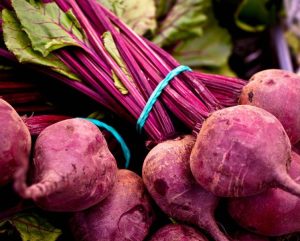
Beet, Red – Red beets are root vegetables known for their earthy flavor and vibrant red-purple color. They are rich in nutrients like folate, manganese, potassium, dietary fiber, and antioxidants such as betalains, which help reduce inflammation and support heart health. Both the roots and greens are edible, with the greens offering additional nutrients like vitamins A and C. Beets can be eaten raw in salads, roasted, boiled, or blended into smoothies and soups. Store beet greens separately from the root, wrapped in a damp cloth or in a plastic bag in the fridge. Use within a few days – they don’t keep long. Beetroots can be stored in a plastic bag in the fridge’s crisper drawer for up to two weeks. To freeze beets for longer storage, slice or chop them, spread on a cookie sheet to flash freeze, then transfer to freezer bags where they can be stored for up to a year.
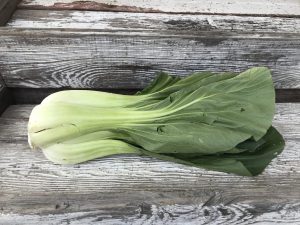 Bok Choy – This leafy green vegetable is a member of the Brassica family. It is rich in vitamins A, C, and K, folate, calcium, and iron. Low in calories and packed with antioxidants, it supports eye health, bone strength, and immune function. Bok choy can be eaten either raw or cooked. With a mild, slightly sweet, and peppery taste, bok choy is versatile in cooking—perfect for stir-fries, soups, and salads. If stir-frying or sautéing, chop the white stalks separately from the green leaves and start cooking the white stalks several minutes before adding the leaves to avoid overcooking the greens. Bok choy can also be grilled by cutting the vegetable lengthwise and drizzling with oil. To store, keep it unwashed in a perforated plastic bag in the refrigerator’s crisper drawer, where it stays fresh for 3-5 days.
Bok Choy – This leafy green vegetable is a member of the Brassica family. It is rich in vitamins A, C, and K, folate, calcium, and iron. Low in calories and packed with antioxidants, it supports eye health, bone strength, and immune function. Bok choy can be eaten either raw or cooked. With a mild, slightly sweet, and peppery taste, bok choy is versatile in cooking—perfect for stir-fries, soups, and salads. If stir-frying or sautéing, chop the white stalks separately from the green leaves and start cooking the white stalks several minutes before adding the leaves to avoid overcooking the greens. Bok choy can also be grilled by cutting the vegetable lengthwise and drizzling with oil. To store, keep it unwashed in a perforated plastic bag in the refrigerator’s crisper drawer, where it stays fresh for 3-5 days.
💡Tip: Dirt often gets trapped in the widest part of the white stalks, so wash it well.
 Cabbage, Chinese (Napa) – Chinese cabbage, also called Napa cabbage, is a tender, pale green variety with a mild, slightly sweet flavor and crisp texture. It’s excellent raw in slaws and salads, quick-pickled for a tangy side, or cooked in stir-fries, soups, dumplings, and fermented as kimchi. Low in calories but rich in fiber, folate, and vitamins C and K, it’s a versatile choice for both fresh and cooked preparations. Store whole heads unwashed in the crisper drawer, loosely wrapped, for up to a week; once cut, use within a few days for best texture and flavor.
Cabbage, Chinese (Napa) – Chinese cabbage, also called Napa cabbage, is a tender, pale green variety with a mild, slightly sweet flavor and crisp texture. It’s excellent raw in slaws and salads, quick-pickled for a tangy side, or cooked in stir-fries, soups, dumplings, and fermented as kimchi. Low in calories but rich in fiber, folate, and vitamins C and K, it’s a versatile choice for both fresh and cooked preparations. Store whole heads unwashed in the crisper drawer, loosely wrapped, for up to a week; once cut, use within a few days for best texture and flavor.
Fun Fact: Napa cabbage has been cultivated in China for over 1,000 years and is one of the most commonly used vegetables in East Asian cuisine, especially in kimchi, where it’s the star ingredient.
💡Tip: Its leaves cook quickly but stems stay crisp, so it’s great for layering texture—try adding it at the end of a stir-fry or soup for a refreshing crunch.

Celery – Celery is a crunchy, low-calorie vegetable known for its mild, slightly salty flavor. It is rich in vitamins K and C, folate, potassium, and fiber, supporting bone health, digestion, and hydration. Celery is often eaten raw as a snack, added to salads, or used as a base in soups, stews, and stir-fries. Store celery in the refrigerator, tightly wrapped in aluminum foil to retain its crispness, where it can stay fresh for up to two weeks. For longer storage, celery can be chopped and frozen.
💡Tip: Don’t forget to use those celery greens! They’re a great addition to cooked beans, salads, eggs. Use leaves to make pesto or dry them and make your own parsley flakes, powder, or salt.
 Cilantro – This fragrant herb has delicate green leaves and a fresh, citrusy flavor. It is widely used in cuisines like Mexican, Indian, and Thai. Cilantro is rich in vitamins A, C, and K, along with antioxidants that support immune health and digestion. It is often used as a garnish, blended into sauces like salsa or chutney, or added to soups and salads for extra flavor. Store cilantro in the refrigerator with the stems in a jar of water, loosely covered with a plastic bag, for up to a week. Alternatively, freeze chopped leaves in ice cube trays with water or oil for longer storage.
Cilantro – This fragrant herb has delicate green leaves and a fresh, citrusy flavor. It is widely used in cuisines like Mexican, Indian, and Thai. Cilantro is rich in vitamins A, C, and K, along with antioxidants that support immune health and digestion. It is often used as a garnish, blended into sauces like salsa or chutney, or added to soups and salads for extra flavor. Store cilantro in the refrigerator with the stems in a jar of water, loosely covered with a plastic bag, for up to a week. Alternatively, freeze chopped leaves in ice cube trays with water or oil for longer storage.
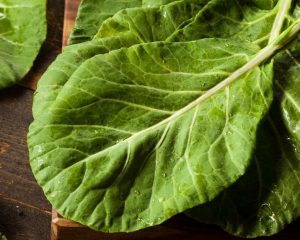 Collard Greens – Collard greens are leafy greens with a slightly bitter, earthy flavor and hearty texture. They are rich in vitamins A, C, and K, calcium, fiber, and antioxidants, which support bone health, immune function, and digestion. Collard greens are often cooked by sautéing, steaming, or simmering in soups and stews, and they’re popular in Southern and African cuisines. Have you used your collard greens to make “lettuce” wraps yet? They hold together better so they are a great substitute. To store, keep collard greens in the refrigerator, wrapped in a damp paper towel inside a plastic bag, where they can stay fresh for up to a week. For longer storage, blanch and freeze them or make green cubes to store for later use.
Collard Greens – Collard greens are leafy greens with a slightly bitter, earthy flavor and hearty texture. They are rich in vitamins A, C, and K, calcium, fiber, and antioxidants, which support bone health, immune function, and digestion. Collard greens are often cooked by sautéing, steaming, or simmering in soups and stews, and they’re popular in Southern and African cuisines. Have you used your collard greens to make “lettuce” wraps yet? They hold together better so they are a great substitute. To store, keep collard greens in the refrigerator, wrapped in a damp paper towel inside a plastic bag, where they can stay fresh for up to a week. For longer storage, blanch and freeze them or make green cubes to store for later use.
 Garlic Chives – Garlic chives are a member of the onion family, but with a distinct garlic flavor. Their long, flat leaves are a milder, more delicate alternative to garlic cloves and can be used both raw and cooked. Nutritionally, garlic chives are rich in vitamins A and C, calcium, and antioxidants. These versatile greens work wonderfully in salads, soups, stir-fries, or as a garnish for almost any savory dish. Store garlic chives in the fridge wrapped in a damp paper towel inside a plastic bag, and use them within 5–7 days.
Garlic Chives – Garlic chives are a member of the onion family, but with a distinct garlic flavor. Their long, flat leaves are a milder, more delicate alternative to garlic cloves and can be used both raw and cooked. Nutritionally, garlic chives are rich in vitamins A and C, calcium, and antioxidants. These versatile greens work wonderfully in salads, soups, stir-fries, or as a garnish for almost any savory dish. Store garlic chives in the fridge wrapped in a damp paper towel inside a plastic bag, and use them within 5–7 days.
Fun Fact: Garlic chives are also known as “Chinese chives” and are used widely in Asian cuisine. They can be used to make a flavorful chive oil, perfect for drizzling on dishes like dumplings or noodle soups.
 Green Garlic – Green garlic is simply young garlic harvested before the bulbs fully form. Its flavor is less intense than mature garlic, with a milder, fresher taste that is both garlicky and onion-like. Green garlic is a great source of vitamins A, C, B6, and minerals like manganese and calcium. It can be used in any recipe that calls for garlic, from sautés to soups, or used raw in dressings and pestos. Store green garlic in the fridge, ideally in a dry container with some airflow, and use it within a week for the freshest taste.
Green Garlic – Green garlic is simply young garlic harvested before the bulbs fully form. Its flavor is less intense than mature garlic, with a milder, fresher taste that is both garlicky and onion-like. Green garlic is a great source of vitamins A, C, B6, and minerals like manganese and calcium. It can be used in any recipe that calls for garlic, from sautés to soups, or used raw in dressings and pestos. Store green garlic in the fridge, ideally in a dry container with some airflow, and use it within a week for the freshest taste.
Fun Fact: Green garlic is a seasonal treat, available only in the spring. While it looks like a scallion or young leek, its flavor is distinctly garlic—making it a great ingredient for early spring recipes!
Ginger – Ginger is a flavorful root widely used as a spice and natural remedy. It has a warm, slightly spicy taste and is rich in bioactive compounds like gingerol, which has anti-inflammatory and antioxidant properties. Ginger aids digestion, relieves nausea, and supports immune health. It is versatile in cooking and used in teas, curries, stir-fries, baked goods, and beverages. Store fresh ginger in a cool, dry place for short-term use or in the refrigerator in a paper towel or airtight bag for extended freshness. For long-term storage, freeze peeled or sliced ginger.
💡Tip: Freeze your fresh ginger for longer storage: Peel and slice or grate the ginger. Freeze in an airtight container or ice cube tray. You can also freeze the whole unpeeled root in a freezer bag. Grate or slice directly from frozen as needed.
 Green Onions – Green onions, also known as scallions, have a mild, slightly sweet onion flavor and are packed with vitamins A and K. They are often used raw in salads, salsas, and garnishes but also add depth to stir-fries, soups, and omelets. Their green tops and white bulbs are both edible, making them a versatile ingredient. Store in the refrigerator, wrapped in a damp paper towel inside a bag, or stand them in a jar of water to keep them fresh longer.
Green Onions – Green onions, also known as scallions, have a mild, slightly sweet onion flavor and are packed with vitamins A and K. They are often used raw in salads, salsas, and garnishes but also add depth to stir-fries, soups, and omelets. Their green tops and white bulbs are both edible, making them a versatile ingredient. Store in the refrigerator, wrapped in a damp paper towel inside a bag, or stand them in a jar of water to keep them fresh longer.
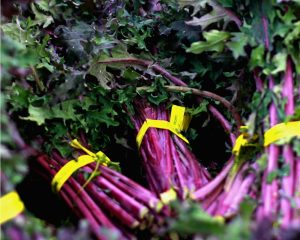 Kale, Red Russian – This variety of kale has tender, flat, slightly fringed leaves with a reddish-purple hue and a mild, sweet flavor. It is rich in vitamins A, C, and K, plus calcium, potassium, and antioxidants, which promote bone health, immunity, and heart health. Red Russian kale can be eaten raw in salads, sautéed, blended into smoothies, or added to soups and stews. This would be delicious in the winter added to a potato soup or vegetable stir fry. I love it sauteed with garlic and olive oil until bright green and tender. Store kale in the refrigerator, wrapped in a damp paper towel and placed in a plastic bag. Stored properly, it can stay fresh for up to a week. To freeze, wash and chop into small pieces and place in a freezer bag.
Kale, Red Russian – This variety of kale has tender, flat, slightly fringed leaves with a reddish-purple hue and a mild, sweet flavor. It is rich in vitamins A, C, and K, plus calcium, potassium, and antioxidants, which promote bone health, immunity, and heart health. Red Russian kale can be eaten raw in salads, sautéed, blended into smoothies, or added to soups and stews. This would be delicious in the winter added to a potato soup or vegetable stir fry. I love it sauteed with garlic and olive oil until bright green and tender. Store kale in the refrigerator, wrapped in a damp paper towel and placed in a plastic bag. Stored properly, it can stay fresh for up to a week. To freeze, wash and chop into small pieces and place in a freezer bag.
Fun fact: NASA has studied kale as a potential crop for space missions because of its high nutrient density. Per calorie, kale has more iron than beef and more calcium than milk. And one cup of raw kale has more vitamin C than a whole orange. (But don’t stop eating those other nutrient-packed foods!)
 Lettuce, Butterhead (Green) – Butterhead lettuce is a tender, mild-flavored leafy green known for its soft, buttery-textured leaves that form loose heads. It’s rich in vitamin K and folate, and because it’s about 95% water, it’s a hydration hero that helps keep you refreshed and nourished. Butterhead lettuce is best stored unwashed, wrapped loosely in a damp paper towel inside a plastic bag, and kept in the refrigerator’s crisper drawer, where it will stay fresh for about 5 to 7 days.
Lettuce, Butterhead (Green) – Butterhead lettuce is a tender, mild-flavored leafy green known for its soft, buttery-textured leaves that form loose heads. It’s rich in vitamin K and folate, and because it’s about 95% water, it’s a hydration hero that helps keep you refreshed and nourished. Butterhead lettuce is best stored unwashed, wrapped loosely in a damp paper towel inside a plastic bag, and kept in the refrigerator’s crisper drawer, where it will stay fresh for about 5 to 7 days.
Fun fact: Butterhead varieties like Boston and Bibb were once prized in royal European gardens for their delicate texture and subtle sweetness.
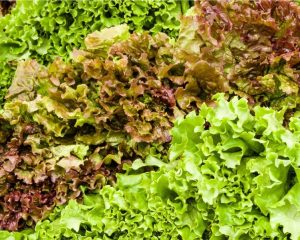
Lettuce, Loose Leaf – Leaf lettuce, known for its loose, leafy structure and mild, slightly sweet flavor, comes in green and red varieties. It is a low-calorie vegetable packed with vitamins A, C, and K, as well as folate and fiber, making it a nutritious choice for salads and wraps. Its tender leaves are best used raw in salads, sandwiches, or as a garnish. Store leaf lettuce in the refrigerator, loosely wrapped in a damp paper towel inside a plastic bag or container, and use it within a week to maintain freshness and crispness.
💡Tip: Don’t miss this exclusive Weekly Salad Greens Subscription to get the freshest greens in the Lehigh Valley every week!
Mushroom Varieties
Store mushrooms in a paper bag or breathable container in the refrigerator, avoiding moisture buildup, and only wash them right before use to maintain freshness.
Mushrooms are super versatile in the kitchen. Here are10 Things You Should Do With Mushrooms.
This roundup of 20 Mushroom Recipeshas you covered with meal ideas for breakfast, lunch, or dinner.
Mushroom, Portobello & Cremini – Portobello mushrooms are mature versions of cremini mushrooms, offering a meaty texture and rich, earthy flavor. Cremini, also known as “baby bellas,” are younger, smaller, and have a firmer texture with a milder taste. Both are low in calories, fat-free, cholesterol-free, and provide B vitamins, selenium, potassium, and antioxidants. Portobellos are ideal for grilling, roasting, or as a meat substitute in burgers, sandwiches, or stuffed recipes. Creminis are great for sautéing, adding to soups, stir-fries, pasta dishes, or as pizza and salad toppings.
Mushroom, Lion’s Mane – Lion’s mane mushrooms are known for their shaggy, white appearance and mild, slightly sweet, seafood-like flavor. Rich in antioxidants, they contain compounds that may support brain health, nerve regeneration, and immune function. These mushrooms can be sautéed, roasted, or added to soups and stir-fries, often used as a meat substitute due to their tender, meaty texture. Store them in a paper bag in the fridge and use within a few days for the best texture and flavor.
💡Tip: The artisan mushroom sampler is a great way to try different varieties of mushrooms. While we can’t predict or guarantee what will be included, the sampler often includes varieties such as enoki, oyster, shiitake, or trumpet.
 Onion, Fresh Bulb – Fresh bulb onions are early, fresh-picked onions harvested after overwintering in the field, with a mild flavor and tender texture that make them a welcome spring treat. They provide vitamin C, folate, antioxidants like quercetin, and sulfur compounds that may help reduce inflammation, lower cholesterol and blood pressure, and even offer antibacterial benefits. Sweeter and more delicate than cured storage onions, they’re delicious raw in salads, salsas, or quick pickles, and also shine when lightly sautéed. Store in the fridge, loosely wrapped or in a ventilated container; use greens within a few days and bulbs within a week for best flavor.
Onion, Fresh Bulb – Fresh bulb onions are early, fresh-picked onions harvested after overwintering in the field, with a mild flavor and tender texture that make them a welcome spring treat. They provide vitamin C, folate, antioxidants like quercetin, and sulfur compounds that may help reduce inflammation, lower cholesterol and blood pressure, and even offer antibacterial benefits. Sweeter and more delicate than cured storage onions, they’re delicious raw in salads, salsas, or quick pickles, and also shine when lightly sautéed. Store in the fridge, loosely wrapped or in a ventilated container; use greens within a few days and bulbs within a week for best flavor.
Fun Fact: The sulfur compounds in onions make your eyes water when chopped, but they also give onions their bold flavor and health benefits, so the tears are definitely worth it. To reduce the sting, chill onions before cutting or slice near an open window to help the compounds disperse.
 Rhubarb – Rhubarb is a unique perennial vegetable known for its vibrant red or green stalks. While technically a vegetable, it’s most often treated as a fruit in cooking, thanks to its tart, tangy flavor. Rich in vitamin K, fiber, and antioxidants, rhubarb is often used in desserts like pies, crumbles, and jams, though it can also complement savory dishes when paired with meat like pork. The leaves of rhubarb contain toxins and should never be eaten, but the stalks are perfectly safe to enjoy. Store rhubarb in the fridge, wrapped in a damp cloth or in a sealed plastic bag, and use within a week for the best flavor.
Rhubarb – Rhubarb is a unique perennial vegetable known for its vibrant red or green stalks. While technically a vegetable, it’s most often treated as a fruit in cooking, thanks to its tart, tangy flavor. Rich in vitamin K, fiber, and antioxidants, rhubarb is often used in desserts like pies, crumbles, and jams, though it can also complement savory dishes when paired with meat like pork. The leaves of rhubarb contain toxins and should never be eaten, but the stalks are perfectly safe to enjoy. Store rhubarb in the fridge, wrapped in a damp cloth or in a sealed plastic bag, and use within a week for the best flavor.
💡Tip: To reduce rhubarb’s natural tartness, cook it with some sugar or honey, or combine it with sweeter fruits like strawberries in desserts for a balanced flavor.
Fun Fact: Rhubarb was originally used in ancient Chinese medicine for its health benefits, long before it became a culinary favorite!
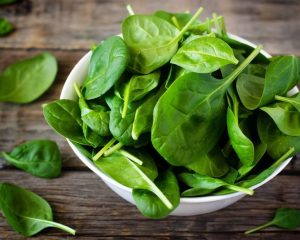 Spinach – Spinach is a nutrient-rich leafy green vegetable packed with vitamins A, C, K, folate, and minerals like iron and magnesium. Low in calories and high in antioxidants, it supports eye health, bone strength, and immune function. Spinach is versatile and can be enjoyed raw in salads, blended into smoothies, or cooked in soups, pasta, and omelets. To store, keep it dry in a perforated plastic bag in the fridge’s crisper drawer, and wash only before use. Properly stored, it stays fresh for 5-7 days.
Spinach – Spinach is a nutrient-rich leafy green vegetable packed with vitamins A, C, K, folate, and minerals like iron and magnesium. Low in calories and high in antioxidants, it supports eye health, bone strength, and immune function. Spinach is versatile and can be enjoyed raw in salads, blended into smoothies, or cooked in soups, pasta, and omelets. To store, keep it dry in a perforated plastic bag in the fridge’s crisper drawer, and wash only before use. Properly stored, it stays fresh for 5-7 days.
Fun Fact: During medieval times, spinach juice was used as ink for artwork due to its rich green pigment.
 Stinging Nettle – This wild, nutrient-rich leafy green is known for its fine, hair-like spines that sting when touched raw, though cooking, drying, or blending neutralizes the sting entirely. It has a mild, earthy flavor similar to spinach and has long been used in both culinary and herbal traditions. Nettles are packed with vitamins A, C, K, and B-complex, as well as iron, calcium, magnesium, potassium, and plant-based protein. They’re popular in soups, pestos, egg dishes, sautéed greens, and teas. Always blanch before eating to remove the sting. Store fresh nettles in the fridge wrapped in a damp paper towel inside a produce bag. Use within a few days, or blanch and either freeze or dry for long-term use.
Stinging Nettle – This wild, nutrient-rich leafy green is known for its fine, hair-like spines that sting when touched raw, though cooking, drying, or blending neutralizes the sting entirely. It has a mild, earthy flavor similar to spinach and has long been used in both culinary and herbal traditions. Nettles are packed with vitamins A, C, K, and B-complex, as well as iron, calcium, magnesium, potassium, and plant-based protein. They’re popular in soups, pestos, egg dishes, sautéed greens, and teas. Always blanch before eating to remove the sting. Store fresh nettles in the fridge wrapped in a damp paper towel inside a produce bag. Use within a few days, or blanch and either freeze or dry for long-term use.
‼️💡Important Tip: Always handle raw nettles with gloves or tongs.
Fun Facts: Stinging nettles aren’t just good for you—they’re good for the planet, too. Nettles grow abundantly without fertilizer and can be harvested multiple times a season. They’re considered a low-impact wild green, especially when foraged responsibly. Plus, they’re a favorite host plant for butterflies like the Red Admiral and Small Tortoiseshell, making them a quiet hero in supporting local pollinators and biodiversity.
 Sweet Potato, Fingerling – Sweet potato fingerlings are small, slender sweet potatoes with thin, edible skin and a naturally sweet, creamy texture. They are rich in fiber, beta-carotene, and vitamin C, promoting digestive and immune health. Roast, sauté, or air-fry them whole for a crispy skin and tender interior, or slice them into fries or hash. Store in a cool, dry place away from light, but avoid refrigeration as it can affect their texture.
Sweet Potato, Fingerling – Sweet potato fingerlings are small, slender sweet potatoes with thin, edible skin and a naturally sweet, creamy texture. They are rich in fiber, beta-carotene, and vitamin C, promoting digestive and immune health. Roast, sauté, or air-fry them whole for a crispy skin and tender interior, or slice them into fries or hash. Store in a cool, dry place away from light, but avoid refrigeration as it can affect their texture.
💡Tip: Roast whole or halved with herbs and spices for a simple side or mash with a touch of butter and cinnamon for a comforting dish.
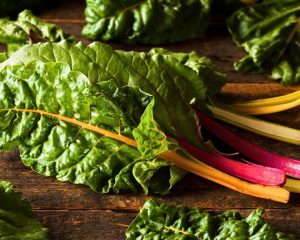 Swiss Chard – Swiss chard is a vibrant leafy green vegetable, rich in vitamins A, C, and K, as well as magnesium, potassium, and iron, making it a nutritious, low-calorie option. The stems come in various colors or simply a whitish green. Both the leaves and the stalks are edible. When picked very young, chard can be part of a green salad. But full-grown chard like in your box today has a very strong flavor and tough stems when eaten raw. Its slightly bitter, earthy flavor pairs well with garlic, lemon, and olive oil, and it can be sautéed or steamed. After cooking for several minutes, it can also be added to rice and beans or omelets. Chard can be sliced or chopped and added to soups. The stems work well in soups, stews, or as a celery substitute. Use Chard any way you would prepare spinach, allowing for longer cooking time for the stems. To store, keep unwashed in a plastic bag or container in the refrigerator’s crisper drawer, using it within 3–5 days; if it wilts, revive it by soaking in cold water before use. Before using, wash well in cool water and separate the leaves from the stems.
Swiss Chard – Swiss chard is a vibrant leafy green vegetable, rich in vitamins A, C, and K, as well as magnesium, potassium, and iron, making it a nutritious, low-calorie option. The stems come in various colors or simply a whitish green. Both the leaves and the stalks are edible. When picked very young, chard can be part of a green salad. But full-grown chard like in your box today has a very strong flavor and tough stems when eaten raw. Its slightly bitter, earthy flavor pairs well with garlic, lemon, and olive oil, and it can be sautéed or steamed. After cooking for several minutes, it can also be added to rice and beans or omelets. Chard can be sliced or chopped and added to soups. The stems work well in soups, stews, or as a celery substitute. Use Chard any way you would prepare spinach, allowing for longer cooking time for the stems. To store, keep unwashed in a plastic bag or container in the refrigerator’s crisper drawer, using it within 3–5 days; if it wilts, revive it by soaking in cold water before use. Before using, wash well in cool water and separate the leaves from the stems.
Fun fact: Chard is in the chenopod family which includes beets, spinach, and quinoa.
 Tomatoes, Red Cherry – Red cherry tomatoes are small, sweet, and juicy with thin skins and vibrant flavor, perfect for raw snacking, salads, roasting, or tossing into pasta and grain bowls. Rich in lycopene, a powerful antioxidant linked to reduced cancer risk, they also offer vitamin C, potassium, and folate. Keep at room temperature out of direct sunlight for best flavor—refrigeration dulls their taste and texture, though very ripe ones can go in the fridge if needed and used soon.
Tomatoes, Red Cherry – Red cherry tomatoes are small, sweet, and juicy with thin skins and vibrant flavor, perfect for raw snacking, salads, roasting, or tossing into pasta and grain bowls. Rich in lycopene, a powerful antioxidant linked to reduced cancer risk, they also offer vitamin C, potassium, and folate. Keep at room temperature out of direct sunlight for best flavor—refrigeration dulls their taste and texture, though very ripe ones can go in the fridge if needed and used soon.
Fun Fact: Cherry tomatoes were once considered ornamental plants in Europe before becoming a kitchen staple. They tend to have higher sugar content than larger tomato varieties, which is why they burst with flavor even when raw.
Don’t forget: Online shopping opens Friday at 1 PM! 🛒 Stock your kitchen with these clean, nourishing ingredients to fuel your family with nutrient-dense meals. Be sure to grab your favorite staples and try something new for vibrant health this season.
Don’t wait to join…
Veggie E-Books
Download these collections of tips and recipes for each veggie. You’ll use these as a reference throughout the season.
Arugula E-Book
Asparagus E-Book
Beets E-Book
Bok Choy E-Book
Cabbage E-Book
Collard Greens E-Book
Fresh Herbs E-Book
Lettuce E-Book
Mushrooms E-Book
Scallion/Green Onion E-Book
Spinach E-Book
Tomatoes E-Book
We’ll keep farming for you!
Reuben and Tessa DeMaster
Willow Haven Farm


